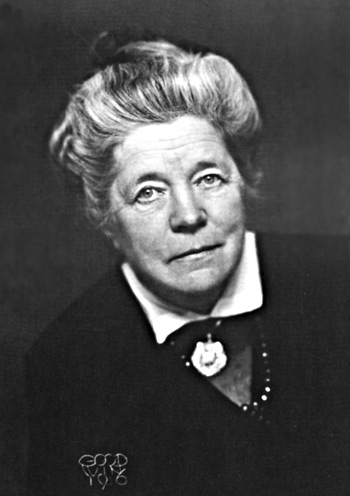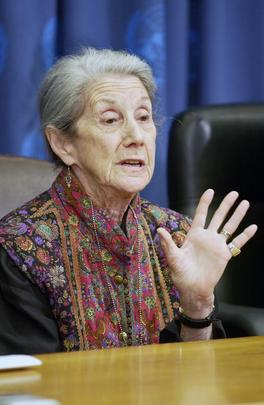by Liz Olson
Each year, writers who have produced the most distinguished literary work of an idealist tendency are awarded the Nobel Prize for Literature. Until 1909, the honor had not been bestowed on a woman. Follow the slideshow to see the distinguished female writers who have since won the Nobel Prize for Literature.
- Selma Lagerlof

- 1909 Nobel Prize
- Selma Lagerlof was a Swedish novelist. Her native Värmland is the background for many of her excellent stories, which deal with peasant life. Her novels include The Story of Gösta Berling (1891, tr. 1898), a romantic tale of a renegade priest, lyrical in style; Jerusalem (1901, tr. 1901–2); and a trilogy (1925–28) which was published in English as The Ring of the Lowenskolds (1931). The short stories of The Wonderful Adventures of Nils (1906, tr. 1907) are classics of children's literature. She received the 1909 Nobel Prize in Literature, the first woman to be thus honored.
- Fun Fact: Lagerlof's most popular work, öGösta Berlings Saga, was published in 1891, but did not receive notice until its Danish translation, which garnered her critical acclaim.
- Source: Columbus Encyclopedia
- Grazia Deledda
![Grazia Deledda]()
- 1926 Nobel Prize
- Grazia Deledda was an Italian novelist born in Sardinia. Her first work, a collection of short stories, was published when she was 19. She was awarded the Nobel Prize in 1926. Deledda's work is lyric and in part naturalistic, and combines sympathy and humor with occasional touches of violence.
- Fun Fact: Deledda first tried to have her stories published in a fashion magazine.
- Source: Columbia Encyclopedia
- Sigrid Undset
![Sigrid Undset]()
- 1928 Nobel Prize
- Sigrid Undset was a Norwegian novelist. Her early novels of contemporary life, among them Jenny (1911), were frank and realistic works in which she described women's struggles for selfhood in a male-dominated society but nonetheless strongly upheld traditional social structures. Her writing, always powerfully ethical, deepened in religious intensity after her conversion (1924) to Roman Catholicism. Undset is most famous for her historical novels dealing with universal human problems.
- Fun Fact: Poverty forced her to do secretarial work for a time (1898–1908).
- Source: Columbia Encyclopedia Photo: Library of Congress
- Pearl Buck
![Pearl Buck]()
- 1938 Nobel Prize
- Pearl Buck was an American novelist who was awarded the 1938 Nobel Prize for Literature. Until 1924 she lived principally in China, where she, her parents, and her first husband, John Lossing Buck, were missionaries. She is famous for vivid, compassionate novels about life in China. The Good Earth (1931; Pulitzer Prize), considered her finest work, describes a Chinese peasant's rise to wealth and brilliantly conveys a sense of the daily life of ordinary Chinese people.
- Fun Fact: In 1949 she founded Welcome House, which provided care for the children of Asian women and American soldiers.
- Source: Columbia Encyclopedia Photo: Library of Congress
- Gabriela Mistral
![Gabriela Mistral]()
- 1945 Nobel Prize
- A Chilean writer, Gabriela Mistral was a teacher in and director of rural schools in Chile before she attained wider acclaim as an educator. Mistral was noted for her revision of the Mexican school system under José Vasconcelos. Subsequently, she served as Chilean consul in various European and Latin American cities and represented her country at the League of Nations and the United Nations. The mystery of childbearing, the sorrow of a tragic love, and a burning desire for justice are recurrent themes of her fluent and lyric verse.
- Fun Fact: Gabriela Mistral's original name was Lucila Godoy Alcayaga.
- Source: Columbia Encyclopedia
- Nelly Sachs
![Nelly Sachs]()
- 1966 Nobel Prize
- Nelly Sachs was a German poet and translator who lived in Sweden. Sachs describes her own experiences and the sufferings of the European Jews in the collections In den Wohnungen des Todes [In the apartments of death] (1947), Das Leiden Israels [Israel's suffering] (1969), and Die Suchende (1960).
- Fun Fact: Nelly Sachs shared the 1966 Nobel Prize in Literature with S. Y. Agnon.
- Source: Columbia Encyclopedia
- Nadine Gordimer
![Nadine Gordimer]()
- 1991 Nobel Prize
- Nadine Gordimer is a South African writer. She published her first short story at age 15 and later many of her stories appeared in The New Yorker magazine. Her collections include Selected Stories (1975), A Soldier's Embrace (1980), Jump and Other Stories (1991), and Loot and Other Stories (2003). A member of the African National Congress, Gordimer was often militantly critical of South African life in her fiction. She tendered little moral hope for whites who lived under apartheid and fought the system in her political life and her writings. In 1991 she won the Nobel Prize in Literature.
- Fun Fact: Gordimer also won the Man Booker Prize for her novel, The Conservationist in 1974.
- Source: Columbia Encyclopedia Photo: UN
- Toni Morrison
![Toni Morrison]()
- 1993 Nobel Prize
- Toni Morrison is an American writer. Her fiction is noted for its poetic language, lush detail, emotional intensity, and sensitive observation of American life as viewed from a variety of African-American perspectives. Her first novel, The Bluest Eye (1970), is the story of a girl ruined by a racist society and its violence. Song of Solomon (1977; National Book Award) established her as one of America's leading novelists. It concerns a middle-class man who achieves self-knowledge through the discovery of his rural black heritage. Her later fiction includes Beloved (1987; Pulitzer Prize), a powerful account of mother love, murder, and the legacy of slavery.
- Fun Fact: Morrison is the first African American to win the Nobel Prize in Literature.
- Source: Columbia Encyclopedia Photo: Timothy Greenfield-Sanders
- Wislawa Szymborska
![The Houston Museum of Natural Science]()
- 1996 Nobel Prize
- Although highly acclaimed in her homeland, Polish writer Szymborska was largely unknown in the West until she won the Nobel Prize for Literature in 1996. Szymborska, who often emphasizes the uniqueness of the individual, has been called an ironic moralist. Her verse is deceptively simple; her language colloquial, precise, and contained; and her tone detached and dryly sardonic.
- Fun Fact: She wrote Dlatego zjemy [that's why we are alive] (1952) and Pytania zadawane sobie [questions put to myself] (1954) under Stalinist pressure and has since repudiated them.
- Source: Columbia Encyclopedia Photo: Michal Kobylinski
- Elfriede Jelinek
![The Houston Museum of Natural Science]()
- 2004 Nobel Prize
- Elfriede Jelinek is an Austrian writer. She became a well-known and extremely controversial figure in her homeland with the publication of three novels, Die Liebhaberinnen, Die Ausgesperrten, and the semiautobiographical Klavierspielerin. A fiercely feminist writer and an outspoken partisan of left-wing political views, she has often focused on issues of power and privilege, mainly the social subordination and violent sexual subjugation of women, and on Austria's Nazi past and nationalist present. She has been particularly praised for her powerful yet sensitive use of multilayered language.
- Fun Fact: Elfriede Jelinek is a trained musician who also studied art history and theater.
- Source: Columbia Encyclopedia
- Doris Lessing
![The Houston Museum of Natural Science]()
- 2007 Nobel Prize
- Doris Lessing is a British writer who is widely regarded as one of the major writers of the mid-20th century and an influential figure among feminists, Lessing writes on a wide variety of themes: Rhodesia, women, communism, and animals. Distinguished for its energy and intelligence, her work is principally concerned with the lives of women-their psychology, politics, work, relationship to men and to their children, and their change of vision as they age.
- Fun Fact: She was brought up on a farm in Southern Rhodesia (now Zimbabwe) and in 1949 went to England, where her first novel, The Grass Is Singing (1950), was published.
- Source: Columbia Encyclopedia

![Grazia Deledda]()
![Sigrid Undset]()
![Pearl Buck]()
![Gabriela Mistral]()
![Nelly Sachs]()
![Nadine Gordimer]()
![Toni Morrison]()
![The Houston Museum of Natural Science]()
![The Houston Museum of Natural Science]()
![The Houston Museum of Natural Science]()











